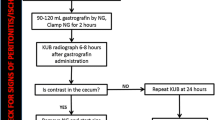Abstract
Postoperative pancreatography after resection of the head of the pancreas often provides important morphologic information. However, the orifice of the residual pancreatic duct is often difficult to detect endoscopically. We evaluated the use of bromthymol blue (BTB), a pH indicator that changes color from orange to a purplish-blue when exposed to alkaline conditions, to assist in the detection of the postoperative orifice. Pancreatography was performed in 46 patients who underwent resection of the head of the pancreas, and the utility of BTB in identifying the orifice of the pancreatic duct during endoscopy was studied. Twenty-one patients underwent endoscopy with the use of BTB. The series consisted of 8 patients who had received a pyloruspreserving pancreaticoduodenectomy with a pancreaticogastrostomy (PPPD-PG), 6 patients who had had pyloruspreserving pancreaticoduodenectomy with a pancreaticojejunostomy (PPPD-PJ), and 7 patients who had undergone a duodenum-preserving resection of the head of the pancreas with a pancreaticoduodenostomy (DPPHR-PD). The remaining 25 patients underwent conventional pancreatography without the use of BTB. This group consisted of 12 patients given a PPPD-PG, 6 patients who had received a PPPD-PJ, and 7 patients who had undergone a DPPHR-PD. The success of the postoperative endoscopic pancreatography was compared in the two groups. In all 21 patients, postoperative pancreatography with BTB resulted in a success rate of 100%, compared to success in only 10 patients who had conventional endoscopy (success rate 40%). This study demonstrated that the use of BTB significantly enhanced the success rate of endoscopic retrograde pancreatography after resection of the head of the pancreas.
Similar content being viewed by others
References
Luckenbach R (1993) Bromthymol blue. Beinstein handbook of organic chemistry. Springer, Berlin Heidelberg New York Tokyo, p 650
Flautner L, Tihanyi T, Szeceny A (1985) A pancreaticogastrostomy: An ideal complement to pancreatic resection with preservation in treatment of chronic pancreatitis. Am J Surg 150:608–611
Kapur B (1986) Pancreaticogastrostomy in pancreaticoduodenal resection for ampullary carcinoma: Experience in 31 cases. Surgery 100:489–493
Takada T (1993) Pylorus-preserving pancreaticoduodenectomy: Techniques and indications Hepatogastroenterology 40:422–425
Suzuki T, Imamura M, Kajiwara H, Kim HC, Miyashita T, Tobe T (1988) A new method of reconstruction after pyloruspreserving pancreaticoduodenectomy. World J Surg 12:645–650
Takada T, Yasuda H, Uchiyama K, Hasegawa H (1993) Duodenum-preserving pancreaticoduodenectomy. A new technique for complete excision of the head of the pancreas with preservation of biliary and alimentary integrity. Hepatogastroenterology 40:356–359
Arvanitakis C (1976) Diagnosis of pancreatic disease by a synthetic peptide: A new test of exocrine pancreatic function. Lancet 27:663
Gyr K (1976) Oral administration of a chymotrypsin-labile peptide—a new test of exocrine pancreatic function in man. Gut 17:27
Takada T, Yasuda H, Uchiyama K, Hasegawa, H, Shikata J, Watanabe S, Shiratori K, Takeuchi T (1989) Postprandial plasma gastrin and secretin concentrations after pancreaticoduodenectomy: A comparison between a pylorus-preserving pancreaticoduodenectomy and the Whipple procedure. Ann Surg 201:47–51
Moriyoshi Y, Takeuchi T, Shiratori K, Watanabe S (1991) Feacal isoamylase activity in patients with pancreatic disease. Pancreas 6:70–76
Takada T, Yasuda H, Uchiyama K, Hasegawa H, Misu Y, Iwagaki T Pancreatic enzyme activity after pylorus-preserving pancreaticoduodenectomy reconstructed with pancreaticogastrostomy. Pancreas (in press)
Whipple AO, Parsons WB, Mullkins CR (1935) Treatment of carcinoma of the ampulla of Vater. Ann Surg 121:763–779
Child CG III (1994) Pancreaticojejunostomy and other problems associated with the surgical management of carcinomainvolving the head of the pancreas. Ann Surg 119:845–855
Imanaga H (1960) A new method of pancreaticoduodenectomy designed to preserve liver and pancreatic function. Surgery 47:577–586
Cattell RB (1944) Radical pancreatoduodenal resection for carcinoma of ampulla of Vater. Surg Clin North Am 24:640–647
Traverso LW, Longmire WP Jr (1978) Preservation of the pylorus in pancreaticoduodenectomy Surg Gynecol Obstet 146:956–962
Beger HG, Buchler M, Bittner R, Uhl W (1990) Duodenumpreserving resection of the head of the pancreas: An alternative to Whipple's procedure in chronic pancreatitis. Hepatogastroenterology 37:283–289
Author information
Authors and Affiliations
About this article
Cite this article
Takada, T., Yasuda, H., Hasegawa, H. et al. Use of bromthymol blue, a pH indicator, for detecting the pancreatic duct orifice after resection of the head of the pancreats. J Hep Bil Pancr Surg 2, 401–405 (1995). https://doi.org/10.1007/BF02349257
Received:
Accepted:
Issue Date:
DOI: https://doi.org/10.1007/BF02349257




